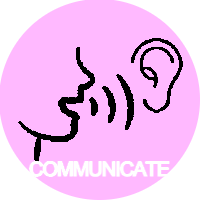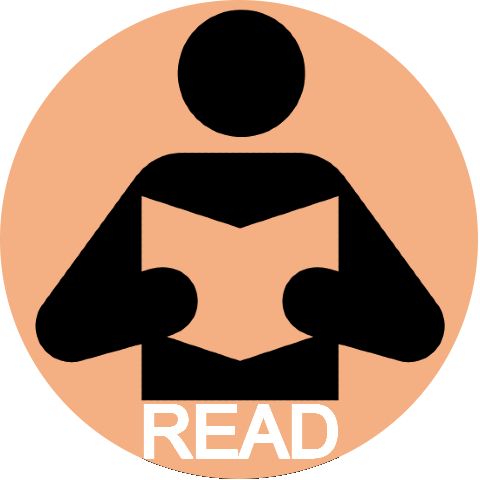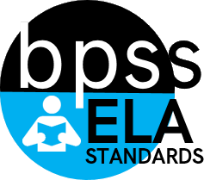*ELA-11.Wr  ELA-11.Wr ELA-11.Wr Strand  | (Wr) Writing
Learners will comprehend, analyze, and evaluate literary and informational texts in various formats, genres, and levels of complexity.
|
Clusters- (TTS) Text Types and Structure
Learners will engage in the writing process and produce a variety of texts determined to address different audiences and purposes.
- (WPC) Writing Process and Craft
Learners will develop, strengthen, and produce writing by planning, drafting, revising, editing, and rewriting.
- (LU) Language Usage
Learners will integrate appropriate language and style to ensure effective readability in writing.
Calculation Method for StrandsStrands are larger groups of related standards. The Strand Grade is a calculation of all the related standards. Click on the standard name below each Strands to access the learning targets and rubrics/ proficiency scales
for individual standards within the domain. |
|
ELA-11.C  ELA-11.C ELA-11.C Strand  | (C) Communications
Learners will organize and express ideas in a format appropriate for the audience and purpose, focusing on skills involved with collaboration, active listening, and oral presentation of information.
|
Clusters- (PC) Presentational Communication
Learners will organize and express information in a format appropriate to the audience and purpose. - (C) Collaboration
Learners will engage in a range of discussions with various partners on relevant topics, texts, and issues.
Calculation Method for StrandsStrands are larger groups of related standards. The Strand Grade is a calculation of all the related standards. Click on the standard name below each Strands to access the learning targets and rubrics/ proficiency scales
for individual standards within the domain. |
|
ELA-11.C.01

|
11th (ELA) Targeted Standard
(C) Communications
(PC) Presentational Communication
Learners will organize and express information in a format appropriate to the audience and purpose.
|
ELA-11.C.01 Construct and deliver formal and informal presentations, incorporating multimedia components when appropriate for the audience and purpose.
 Proficiency Scale Proficiency Scale
Progressions
Standard C.01: Presentations
- ELA-00.C.01 Describe personal interests or tell stories orally to a targeted audience.
- ELA-01.C.01 Describe people, places, things, and events with relevant details expressing ideas orally to a targeted audience.
- ELA-02.C.01 Report on a topic or text, tell a story or recount an experience to a targeted audience with relevant facts and descriptive details.
- ELA-03.C.01 Report relevant facts and descriptive details of a topic, text, story, or experience for a targeted audience.
- ELA-04.C.01 Organize and present information as an individual and group for a formal and informal audience.
- ELA-05.C.01 Organize and present information as an individual and group for a formal and informal audience.
- ELA-06.C.01 Construct and deliver formal and informal presentations considering the provided audience and purpose, including multimedia components when appropriate.
- ELA-07.C.01 Construct and deliver formal and informal presentations considering the audience and purpose using multimedia components when appropriate.
- ELA-08.C.01 Construct and deliver formal and informal presentations considering the audience and purpose, including multimedia components when appropriate.
- ELA-09.C.01 Construct and deliver formal and informal presentations, incorporating multimedia components when appropriate for the audience and purpose.
- ELA-10.C.01 Construct and deliver formal and informal presentations, incorporating multimedia components when appropriate for the audience and purpose.
- ELA-11.C.01 Construct and deliver formal and informal presentations, incorporating multimedia components when appropriate for the audience and purpose.
- ELA-12.C.01 Construct and deliver formal and informal presentations, incorporating multimedia components when appropriate for the audience and purpose.
|
|
ELA-11.C.02  | 11th (ELA) Targeted Standard (C) Communications (PC) Presentational Communication
Learners will organize and express information in a format appropriate to the audience and purpose.
|
ELA-11.C.02 Implement proper verbal and nonverbal communication for the task and situation.
 Proficiency Scale Proficiency Scale
Progressions
Standard C.02: Giving Oral Presentations - ELA-00.C.02 Speak audibly to express thoughts, feelings, and ideas.
- ELA-01.C.02 Speak audibly in complete sentences to express thoughts, feelings, and ideas.
- ELA-02.C.02 Speak audibly in complete sentences when proper to the task and situation to provide requested details or clarifications.
- ELA-03.C.02 Speak in complete sentences using proper eye contact and volume to express thoughts, feelings, and ideas.
- ELA-04.C.02 Present ideas using proper eye contact, body language, and volume in formal and informal situations.
- ELA-05.C.02 Present ideas using proper eye contact, body language, and volume in formal and informal situations.
- ELA-06.C.02 Present ideas using proper eye contact, body language, volume, and pronunciation in formal and informal presentations.
- ELA-07.C.02 Present ideas using proper eye contact, body language, volume, and pronunciation in formal and informal presentations.
- ELA-08.C.02 Present ideas using proper eye contact, body language, volume, and pronunciation in formal and informal presentations.
- ELA-09.C.02 Implement proper verbal and nonverbal communication for tasks and situations.
- ELA-10.C.02 Implement proper verbal and nonverbal communication for tasks and situations.
- ELA-11.C.02 Implement proper verbal and nonverbal communication for the task and situation.
- ELA-12.C.02 Implement proper verbal and nonverbal communication for the task and situation.
|
|
ELA-11.C.05

|
11th (ELA) Targeted Standard
(C) Communications
(C) Collaboration
Learners will engage in a range of discussions with various partners on relevant topics, texts, and issues.
|
ELA-11.C.05 Prepare for discussions by reading and researching ideas.
 Proficiency Scale Proficiency Scale
Progressions
Standard C.05: Preparations for Discussions
- ELA-06.C.05 Prepare for discussions by finding relevant connections to the topic or text.
- ELA-07.C.05 Prepare for discussions by finding relevant and specific connections to the topic or text.
- ELA-08.C.05 Prepare for discussions by finding relevant and specific connections to the topic or text.
- ELA-09.C.05 Prepare for discussions by reading and researching ideas to be discussed.
- ELA-10.C.05 Prepare for discussions by reading and researching ideas to be discussed.
- ELA-11.C.05 Prepare for discussions by reading and researching ideas.
- ELA-12.C.05 Prepare for discussions by reading and researching ideas.
|
|
ELA-11.C.06

|
11th (ELA) Targeted Standard
(C) Communications
(C) Collaboration
Learners will engage in a range of discussions with various partners on relevant topics, texts, and issues.
|
ELA-11.C.06 Engage in respectful discussions or debates.
 Proficiency Scale Proficiency Scale
Sub-Standards
- (a.) Listen to acknowledge varying perspectives and evaluate the speaker’s logic or argument.
- (b.) Critique the presentation of ideas.
- (c.) Present or share synthesized research and information.
- (d.) Ask and respond to questions to propel discussion.
Progressions
Standard C.06: Group Discussion and Debate
- ELA-00.C.06 Participate in conversations by listening to others and taking turns speaking.
- ELA-01.C.06 Participate in conversations by listening to others and taking turns speaking about topics, continuing through multiple exchanges.
- ELA-02.C.06 Participate in conversations by linking comments to the remarks of others and asking questions.
- ELA-03.C.06 Engage in conversations by asking and answering questions using active listening skills.
- ELA-04.C.06 Engage in a range of discussions by using active listening skills, posing, and responding to specific questions.
- ELA-05.C.06 Engage in a range of discussions using active listening skills, posing and responding to specific questions to clarify information.
- ELA-06.C.06 Engage in a range of discussions and/or debates using active listening skills to be focused and present.
- ELA-07.C.06 Engage in a range of discussions and/or debates.
- ELA-08.C.06 Engage in a range of discussions and/or debates.
- ELA-09.C.06 Engage in respectful discussions or debates.
- ELA-10.C.06 Engage in respectful discussions or debates.
- ELA-11.C.06 Engage in respectful discussions or debates.
- ELA-12.C.06 Engage in respectful discussions or debates.
|
|
ELA-11.C.07  | 11th (ELA) Targeted Standard (C) Communications (C) Collaboration
Learners will engage in a range of discussions with various partners on relevant topics, texts, and issues.
|
ELA-11.C.07 Collaborate on a specific task or purpose in a productive climate by establishing and following norms, processes, and roles.
 Proficiency Scale Proficiency Scale
Progressions
Standard C.07: Group Collaboration
- ELA-00.C.07 Work collaboratively by following agreed-upon rules and simple one- and two-step oral directions.*
- ELA-01.C.07 Work collaboratively by following agreed-upon rules and simple two- and three-step oral directions and offering one- and two-step verbal directions.
- ELA-02.C.07 Work collaboratively by following agreed-upon rules and following/offering multi-step oral directions.
- ELA-03.C.07 Engage collaboratively by following agreed-upon rules.
- ELA-04.C.07 Engage collaboratively to accomplish a common goal or purpose.
- ELA-05.C.07 Engage collaboratively to accomplish a common goal or purpose.
- ELA-06.C.07 Collaborate cooperatively with peers to accomplish a common goal or purpose.
- ELA-07.C.07 Collaborate cooperatively with peers to accomplish a common goal or purpose.
- ELA-08.C.07 Collaborate cooperatively with peers to accomplish a common goal or purpose.
- ELA-09.C.07 Collaborate on a specific task or purpose in a productive climate by following norms, processes, and roles.
- ELA-10.C.07 Collaborate on a specific task or purpose in a productive climate by following norms, processes, and roles.
- ELA-11.C.07 Collaborate on a specific task or purpose in a productive climate by establishing and following norms, processes, and roles.
- ELA-12.C.07 Collaborate on a specific task or purpose in a productive climate by establishing and following norms, processes, and roles.
|
|
ELA-11.IR  ELA-11.IR ELA-11.IR Strand  | (IR) Inquiry and Research
Learners will pose and revise complex questions, identify and connect pertinent information, plan and prepare an inquiry process, and arrive at a plausible conclusion or solution.
|
Clusters- (S1) Select a Research Topic and Develop Research Question(s)(begins in third grade)
- (S2) Locate and Select Information(begins in second grade)
- (S3) Organize Research Results(begins in second grade)
- (S4) Determining Credibility and Evaluating Sources(begins in third grade)
- (S5) Citing Sources(begins in fourth grade)
Calculation Method for StrandsStrands are larger groups of related standards. The Strand Grade is a calculation of all the related standards. Click on the standard name below each Strands to access the learning targets and rubrics/ proficiency scales
for individual standards within the domain. |
|
ELA-11.IR.01  | 11th (ELA) Targeted Standard (IR) Inquiry and Research (S1) Select and Develop Research
Learner selects a research topic and develops research question(s).
|
ELA-11.IR.01 Develop complex, pertinent research questions and narrow or broaden the inquiry.
 Proficiency Scale Proficiency Scale
Progressions
Standard IR.01: (begins in third grade)- ELA-03.IR.01 Choose a topic of interest to research.
- ELA-04.IR.01 Choose a topic of interest and develop several questions about it for research.
- ELA-05.IR.01 Choose a topic of interest and develop a focus question for research.
- ELA-06.IR.01 Develop a research question based on a given topic, problem, or need.
- ELA-07.IR.01 Develop a research question based on a given topic, problem, or need.
- ELA-08.IR.01 Develop research questions based on self-generated topics, problems, or needs.
- ELA-09.IR.01 Develop pertinent research questions and narrow or broaden the inquiry.
- ELA-10.IR.01 Develop pertinent research questions and narrow or broaden the inquiry.
- ELA-11.IR.01 Develop complex, pertinent research questions and narrow or broaden the inquiry.
- ELA-12.IR.01 Develop complex, pertinent research questions and narrow or broaden the inquiry.
|
|
ELA-11.IR.02

|
11th (ELA) Targeted Standard
(IR) Inquiry and Research
(S2) Locate and Select Information
Learner locates and select information for research.
|
ELA-11.IR.02 Gather and interpret relevant information, from both primary and secondary sources, for a variety of purposes.
 Proficiency Scale Proficiency Scale
Progressions
Standard IR.02: (begins in second grade)
- ELA-02.IR.02 Locate important information on a topic in a provided source during a shared or interactive experience.
- ELA-03.IR.02 Locate relevant information on a topic from a provided credible source or database.
- ELA-04.IR.02 Locate relevant information on a topic from a provided credible source or database.
- ELA-05.IR.02 Locate relevant information from a pair of provided, credible sources.
- ELA-06.IR.02 Locate relevant information from a provided set of credible sources.
- ELA-07.IR.02 Locate relevant information from a variety of credible sources.
- ELA-08.IR.02 Gather and interpret relevant information for a variety of purposes.
- ELA-09.IR.02 Gather and interpret relevant information from primary and secondary sources for a variety of purposes.
- ELA-10.IR.02 Gather and interpret relevant information from primary and secondary sources for a variety of purposes.
- ELA-11.IR.02 Gather and interpret relevant information, from both primary and secondary sources, for a variety of purposes.
- ELA-12.IR.02 Gather and interpret relevant information, from both primary and secondary sources, for a variety of purposes.
|
|
ELA-11.IR.03  | 11th (ELA) Targeted Standard (IR) Inquiry and Research (S3) Organize Research Results
Learner organize research results.
|
ELA-11.IR.03 Organize relevant information from a variety of sources.
 Proficiency Scale Proficiency Scale
Progressions
Standard IR.03: (begins in second grade)- ELA-02.IR.03 Use organizational tools to track information from a provided pair of sources relevant to a topic in a shared or interactive experience.
- ELA-03.IR.03 Use organizational tools to track information from a provided credible source relevant to a topic.
- ELA-04.IR.03 Use organizational tools and a notetaking strategy to track relevant information from a provided credible source on a topic.
- ELA-05.IR.03 Use organizational tools and notetaking strategies to track relevant information from a provided pair of credible sources on a topic.
- ELA-06.IR.03 Organize main concepts from provided sources using a given notetaking strategy.
- ELA-07.IR.03 Organize main concepts from provided and self-selected sources using given and self-generated notetaking strategies.
- ELA-08.IR.03 Organize main concepts from a variety of sources using multiple notetaking strategies.
- ELA-09.IR.03 Organize relevant information from a variety of sources.
- ELA-10.IR.03 Organize relevant information from a variety of sources.
- ELA-11.IR.03 Organize relevant information from a variety of sources.
- ELA-12.IR.03 Organize relevant information from a variety of sources.
|
|
ELA-11.IR.04  | 11th (ELA) Targeted Standard (IR) Inquiry and Research (S4) Determining Credibility and Evaluating Sources
Learner determines credibility and evaluates sources for research.
|
ELA-11.IR.04 Evaluate the credibility of a source based on bias, argumentative reasoning, perspective, and purpose.
 Proficiency Scale Proficiency Scale
Progressions
Standard IR.04: (begins in third grade)- ELA-03.IR.04 Identify a fact or an opinion based on information provided by the author.
- ELA-04.IR.04 Determine a fact or opinion based on information provided by the author.
- ELA-05.IR.04 Identify facts and multiple perspectives from credible sources.
- ELA-06.IR.04 Analyze information from credible sources considering multiple perspectives.
- ELA-07.IR.04 Analyze information from credible sources considering multiple perspectives and identifying biases.
- ELA-08.IR.04 Analyze the credibility of a source based on bias, perspective, and purpose.
- ELA-09.IR.04 Evaluate the credibility of a source based on bias, perspective, and purpose.
- ELA-10.IR.04 Evaluate the credibility of a source based on bias, perspective, and purpose.
- ELA-11.IR.04 Evaluate the credibility of a source based on bias, argumentative reasoning, perspective, and purpose.
- ELA-12.IR.04 Evaluate the credibility of a source based on bias, argumentative reasoning, perspective, and purpose.
|
|
ELA-11.IR.05

|
11th (ELA) Targeted Standard
(IR) Inquiry and Research
(S5) Citing Sources
Learner cites sources for research.
|
ELA-11.IR.05 Integrate information from sources using a standardized format.
 Proficiency Scale Proficiency Scale
Sub-Standards
- (a.) Reference sources for quotations, paraphrases, and/or summaries to avoid plagiarism and maintain academic integrity.
- (b.) Generate a citation/bibliography page using a discipline-specific format.
Progressions
Standard IR.05: (begins in fourth grade)
- ELA-04.IR.05 Cite and reference sources with a bibliography page using an approved citation format to avoid plagiarism.
- ELA-05.IR.05 Cite and reference sources with a bibliography page using an approved citation format to avoid plagiarism.
- ELA-06.IR.05 Integrate information from sources using a standardized format.
- ELA-07.IR.05 Integrate information from sources using a standardized format.
- ELA-08.IR.05 Integrate information from sources using a standardized format.
- ELA-09.IR.05 Integrate information from sources using a standardized format.
- ELA-10.IR.05 Integrate information from sources using a standardized format.
- ELA-11.IR.05 Integrate information from sources using a standardized format.
- ELA-12.IR.05 Integrate information from sources using a standardized format.
|
|
ELA-11.R  ELA-11.R ELA-11.R Strand  | (R) Reading
Learners will comprehend, analyze, and evaluate literary and informational texts in various formats, genres, and levels of complexity.
|
Clusters- (C) Comprehension
Learners will read to understand various complex literary and informational texts.
- (TA) Text Analysis
Learners will analyze, interpret, and evaluate complex literary and informational texts that include a wide variety of genres and formats.
Calculation Method for StrandsStrands are larger groups of related standards. The Strand Grade is a calculation of all the related standards. Click on the standard name below each Strands to access the learning targets and rubrics/ proficiency scales
for individual standards within the domain. |
|
ELA-11.R.02  | 11th (ELA) Targeted Standard (R) Reading (C) Comprehension
Learners will read to understand a variety of complex literary and informational texts.
|
ELA-11.R.02 Comprehend a variety of texts with multiple levels of complexity while developing inferences and providing relevant textual evidence and reasoning.
 Proficiency Scale Proficiency Scale
Progressions
Standard R.02: Text Comprehension/Inferences- ELA-00.R.02 Respond to a variety of texts, photographs, or illustrations before, during, and after shared reading or other text-listening experiences to compare, contrast, predict, or infer.
- ELA-01.R.02 Ask and answer questions about a variety of texts, genres, photographs, or illustrations before, during, and after shared reading or other text-listening experiences to compare, contrast, predict, or infer.
- ELA-02.R.02 Ask and answer questions about key details before, during, and after reading a variety of literary and informational texts to compare, contrast, predict, or infer.*
- ELA-03.R.02 Ask and answer questions about key details before, during, and after reading a variety of genres, literary, and informational texts using text evidence to compare, contrast, predict, and infer.*
- ELA-04.R.02 Make inferences while reading a variety of genres, literary, and informational texts; providing text evidence.*
- ELA-05.R.02 Make inferences drawn from the text during and after reading a variety of genres, literary, and informational texts.*
- ELA-06.R.02 Comprehend a variety of texts while developing inferences and providing supportive textual evidence.
- ELA-07.R.02 Comprehend a variety of texts while developing inferences and providing supportive textual evidence and reasoning.
- ELA-08.R.02 Comprehend a variety of texts while developing inferences and providing relevant textual evidence and reasoning.
- ELA-09.R.02 Comprehend a variety of texts with multiple levels of complexity while developing inferences and providing relevant textual evidence and reasoning.
- ELA-10.R.02 Comprehend a variety of texts with multiple levels of complexity while developing inferences and providing relevant textual evidence and reasoning.
- ELA-11.R.02 Comprehend a variety of texts with multiple levels of complexity while developing inferences and providing relevant textual evidence and reasoning.
- ELA-12.R.02 Comprehend a variety of texts with multiple levels of complexity while developing inferences and providing relevant textual evidence and reasoning.
|
|
ELA-11.R.03a  | 11th (ELA) Targeted Standard (R) Reading (C) Comprehension
Learners will read to understand a variety of complex literary and informational texts.
|
ELA-11.R.03a Summarize and/or paraphrase nonfiction texts objectively, including relevant information.
 Proficiency Scale Proficiency Scale
Progressions
Standard R.03a: Summarizing Nonfiction Text- ELA-00.R.03a Tell about the informational text, photographs, or illustrations before, during, or after a shared reading or other text-listening experience.*
- ELA-01.R.03a Identify the topic of an informational text, photograph, or illustration during or after a shared reading or other text-listening experiences.*
- ELA-02.R.03a Identify the main idea with supporting details during or after reading an informational text or passage.*
- ELA-03.R.03a Summarize the main idea(s) with supporting details during or after reading an informational text or passage.*
- ELA-04.R.03a Summarize an informational text or passage, stating the main idea(s) and providing supporting details.*
- ELA-05.R.03a Summarize an informational text or passage, stating the main idea(s) and providing supporting details.*
- ELA-06.R.03a Summarize nonfiction texts objectively, including relevant details.
- ELA-07.R.03a Summarize and/or paraphrase nonfiction texts objectively, including relevant details and avoiding unnecessary information.
- ELA-08.R.03a Summarize and/or paraphrase nonfiction texts objectively, including relevant details and avoiding unnecessary information.
- ELA-09.R.03a Summarize and/or paraphrase nonfiction texts objectively, including relevant information.
- ELA-10.R.03a Summarize and/or paraphrase nonfiction texts objectively, including relevant information.
- ELA-11.R.03a Summarize and/or paraphrase nonfiction texts objectively, including relevant information.
- ELA-12.R.03a Summarize and/or paraphrase nonfiction texts objectively, including relevant information.
|
|
ELA-11.R.03b  | 11th (ELA) Targeted Standard (R) Reading (C) Comprehension
Learners will read to understand a variety of complex literary and informational texts.
|
ELA-11.R.03b Summarize and paraphrase literary texts objectively, including relevant information.
 Proficiency Scale Proficiency Scale
Progressions Standard R.03b: Summarize Literary Text- ELA-00.R.03b Tell about characters and setting in a literary text during or after a shared reading or other text-listening experience.*
- ELA-01.R.03b Identify characters, setting, and plot in a literary text during or after a shared reading or other text-listening experience.*
- ELA-02.R.03b Retell the plot to include the beginning, middle, and end of a literary text after reading.*
- ELA-03.R.03b Summarize the story by including major story elements after reading a literary text or passage.*
- ELA-04.R.03b Summarize the story by including major story elements after reading a literary text or passage.*
- ELA-05.R.03b Summarize a story by including major story elements after reading a literary text.*
- ELA-06.R.03b Summarize literary texts objectively, including relevant details.
- ELA-07.R.03b Summarize and/or paraphrase literary texts objectively, including relevant details and avoiding unnecessary information.
- ELA-08.R.03b Summarize and/or paraphrase literary texts objectively, including relevant details and avoiding unnecessary information.
- ELA-09.R.03b Summarize and/or paraphrase literary texts objectively, including relevant information.
- ELA-10.R.03b Summarize and/or paraphrase literary texts objectively, including relevant information.
- ELA-11.R.03b Summarize and paraphrase literary texts objectively, including relevant information.
- ELA-12.R.03b Summarize and paraphrase literary texts objectively, including relevant information.
|
|
ELA-11.R.04  | 11th (ELA) Targeted Standard (R) Reading (C) Comprehension
Learners will read to understand a variety of complex literary and informational texts.
|
ELA-11.R.04 Determine the main idea(s), claim(s), or theme(s) as they develop over the course of the text and interact with each other, and support them with textual evidence.
 Proficiency Scale Proficiency Scale
Progressions
Standard R.04: Main Idea/Claim/Theme- ELA-04.R.04 Identify a theme based on textual evidence.*
- ELA-05.R.04 Determine a claim or theme based on textual evidence.*
- ELA-06.R.04 Determine main idea(s), claim(s), or theme(s) and provide supporting textual evidence.
- ELA-07.R.04 Determine main idea(s), claim(s), or theme(s) and provide supporting textual evidence and reasoning.
- ELA-08.R.04 Determine a main idea(s), claim(s), or theme(s) and provide relevant textual evidence and supportive reasoning.
- ELA-09.R.04 Determine the main idea(s), claim(s), or theme(s) as they develop over the course of the text and support them with textual evidence.
- ELA-10.R.04 Determine the main idea(s), claim(s), or theme(s) as they develop over the course of the text and support them with textual evidence.
- ELA-11.R.04 Determine the main idea(s), claim(s), or theme(s) as they develop over the course of the text and interact with each other, and support them with textual evidence.
- ELA-12.R.04 Determine the main idea(s), claim(s), or theme(s) as they develop over the course of the text and interact with each other, and support them with textual evidence.
|
|
ELA-11.R.05  | 11th (ELA) Targeted Standard (R) Reading (C) Comprehension
Learners will read to understand a variety of complex literary and informational texts.
|
ELA-11.R.05 Determine the meaning, purpose, and impact of words and phrases as they are used in the text, including academic vocabulary, figurative, ambiguous, and connotative meanings.
 Proficiency Scale Proficiency Scale
Progressions Standard R.05: Use Text to Determine Word Meaning- ELA-00.R.05 Determine the meaning of unknown and multiple-meaning words and phrases through read-alouds or other text-listening experiences.*
- ELA-01.R.05 Determine the meaning of unknown and multiple-meaning words and phrases through read-alouds or other text-listening experiences.*
- ELA-02.R.05 Determine the meaning of unknown words and phrases through a variety of text experiences.*
- ELA-03.R.05 Determine the meaning of unknown and multi-meaning words within a text.*
- ELA-04.R.05 Determine the meaning of unknown and multiple-meaning words and phrases within a text.*
- ELA-05.R.05 Determine the meaning of unknown and multiple-meaning words and phrases within a text.*
- ELA-06.R.05 Determine the meaning of words and phrases as they are used in the text, including figurative, denotative, and connotative meanings.
- ELA-07.R.05 Determine the meaning and purpose of words and phrases as they contribute to the text, including figurative, denotative, and connotative meanings.
- ELA-08.R.05 Determine the meaning and purpose of words and phrases as they contribute to the text, including figurative, denotative, and connotative meanings.
- ELA-09.R.05 Determine the meaning and purpose of words and phrases as they are used in the text, including academic vocabulary, figurative, ambiguous, and connotative meanings.
- ELA-10.R.05 Determine the meaning and purpose of words and phrases as they are used in the text, including academic vocabulary, figurative, ambiguous, and connotative meanings.
- ELA-11.R.05 Determine the meaning, purpose, and impact of words and phrases as they are used in the text, including academic vocabulary, figurative, ambiguous, and connotative meanings.
- ELA-12.R.05 Determine the meaning, purpose, and impact of words and phrases as they are used in the text, including academic vocabulary, figurative, ambiguous, and connotative meanings.
|
|
ELA-11.R.06  | 11 (ELA) Targeted Standard (R) Reading (TA) Text Analysis
Learners will analyze, interpret, and evaluate complex literary and informational texts that include a wide variety of genres and formats.
|
ELA-11.R.06 Analyze and evaluate how the author's choice in structure, form, and format supports the purpose, contributes to the meaning, or impacts the audience.
 Proficiency Scale Proficiency Scale
Progressions Standard R.06: Text Features and Structure - ELA-00.R.06 Identify photographs, illustrations, and labels during or after a shared reading or other text-listening experience.
- ELA-01.R.06 Recognize basic text features during or after a shared reading or other text-listening experience.
- ELA-02.R.06 Identify text features and use previously learned text features to read and understand a text or passage.*
- ELA-03.R.06 Use text features and previously learned text features to read and understand a text or passage.*
- ELA-04.R.06 Determine the structure of an informational text:
- ELA-05.R.06 Describe the structure of informational texts:
- ELA-06.R.06 Describe how a paragraph, chapter, stanza, or section fits into the overall structure of a text and contributes to the development of ideas.
- ELA-07.R.06 Analyze the structure an author uses to organize a text, including how the major sections or stanzas contribute to the whole and the development of ideas, and the overall purpose of the text.
- ELA-08.R.06 Analyze the structure an author uses to organize a text, including how sections, paragraphs, stanzas, and/or particular sentences contribute to the development of ideas and the overall purpose of the text.
- ELA-09.R.06 Analyze how the author's choice in structure, form, and format supports the purpose, contributes to the meaning, or impacts the audience.
- ELA-10.R.06 Analyze how the author's choice in structure, form, and format supports the purpose, contributes to the meaning, or impacts the audience.
- ELA-11.R.06 Analyze and evaluate how the author's choice in structure, form, and format supports the purpose, contributes to the meaning, or impacts the audience.
- ELA-12.R.06 Analyze and evaluate how the author's choice in structure, form, and format supports the purpose, contributes to the meaning, or impacts the audience.
|
|
ELA-11.R.07  | 11th (ELA) Targeted Standard (R) Reading (TA) Text Analysis
Learners will analyze, interpret, and evaluate complex literary and informational texts that include a wide variety of genres and formats.
|
ELA-11.R.07 Analyze the cumulative impact of specific style, syntax, and word choices on meaning, mood, and tone, including figurative and ambiguous language.
 Proficiency Scale Proficiency Scale
Progressions Standard R.07: Literary Devices - ELA-03.R.07 Identify examples of literary devices:
- ELA-04.R.07 Identify and use literary devices:
- ELA-05.R.07 Determine how literary devices contribute to the meaning of a text:*
- ELA-06.R.07 Describe how an author uses figurative language and specific word choice to affect meaning in a text.
- ELA-07.R.07 Analyze how an author uses figurative language and specific word choice to affect the meaning in a text.
- ELA-08.R.07 Analyze how an author uses figurative language and specific word choice to affect the meaning and tone.
- ELA-09.R.07 Analyze the impact of specific style, syntax, and word choices on meaning, mood, and tone, including figurative and ambiguous language.
- ELA-10.R.07 Analyze the impact of specific style, syntax, and word choices on meaning, mood, and tone, including figurative and ambiguous language.
- ELA-11.R.07 Analyze the cumulative impact of specific style, syntax, and word choices on meaning, mood, and tone, including figurative and ambiguous language.
- ELA-12.R.07 Analyze the cumulative impact of specific style, syntax, and word choices on meaning, mood, and tone, including figurative and ambiguous language.
|
|


 (C)
(C)
 (R)
(R)
 (Wr)
(Wr)
 (IR)
(IR)





